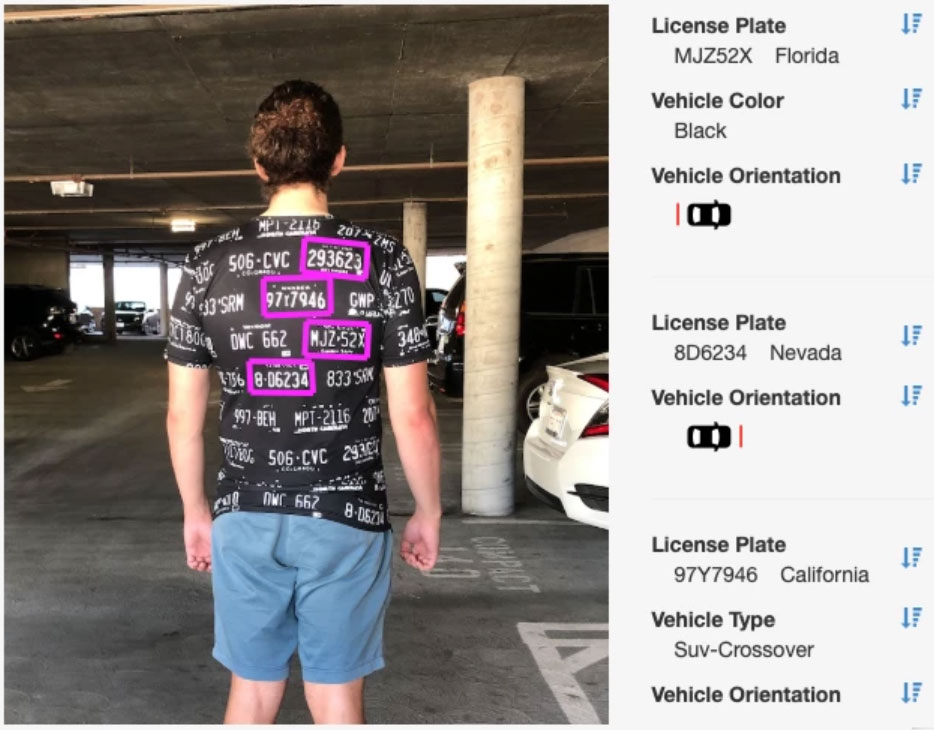This Hacker Fools License Plate Readers with Fashion

LAS VEGAS -- You can hack the police simply by wearing the right kind of dress, skirt or shirt.
At the DEF CON hacker conference here this past weekend, clothing designer Kate Rose debuted a new line of clothing with patterns designed to confuse the automated license plate readers (ALPRs) mounted on police cars, traffic lights and roadways.
The clothing, available on AdversarialFashion.com, features prints of what look like license plates in three different formats. One that spells out the text of the Fourth Amendment of the U.S. Constitution -- the amendment that guarantees the right of privacy -- in the classic California black-and-gold '60s-style plate pattern.
If you walk down a city street wearing this clothing, an ALPR will read your shirt, skirt, dress, jacket or hoodie, get confused and possibly not be able to read all the real license plates on cars driving by or parked.
"Automated license plate readers are always on and always tracking everyone," Rose said. "Over time, the data can reveal a vehicle's historical travels, but there are ways to confound this technology."
Rose explained that it took her a lot of trial and error, license plate images and open-source license-plate-reader software to get the right kind of pattern. Certain fonts wouldn't work, for example, and certain fabrics and weaves worked better than others.

She said it was important to strike back at surveillance tools, because automated license plate readers aren't as innocuous at they may seem.
Get instant access to breaking news, the hottest reviews, great deals and helpful tips.
Rose cited the case of a Los Angeles-area mall that scanned the plates of cars parked in its garage so that it could tell patrons where their cars were parked -- but which also sold the scanned-plate data to Immigration and Customs Enforcement.
"These systems are often deployed by people who are not AI [artificial intelligence] experts," Rose said. "They generate massive amounts of PII [personally identifiable information] in databases that are themselves susceptible to attack," as in the recent case of a Border Patrol license-plate database that got hacked.
For the moment, Rose's line of clothing is limited to the three different license-plate patterns, but she might next move into new patterns that confound facial-recognition and facial-identification cameras. A Dutch designer has already experimented with that.
Not only is facial identification very intrusive, she said, but it's often wrong.
"A Chinese facial-recognition program gave a prominent businessowman a jaywalking ticket because her face was in an ad on the side of a moving bus," Rose said.
Rose's website not only sells the clothing, but also includes instructions on how to make your own clothing with patterns designed to confuse license-plate readers and facial recognition and identification. Her site also has links to open-source software programs that can be used to test and develop your patterns.
"It's never been easier to create these things," Rose said.

Paul Wagenseil is a senior editor at Tom's Guide focused on security and privacy. He has also been a dishwasher, fry cook, long-haul driver, code monkey and video editor. He's been rooting around in the information-security space for more than 15 years at FoxNews.com, SecurityNewsDaily, TechNewsDaily and Tom's Guide, has presented talks at the ShmooCon, DerbyCon and BSides Las Vegas hacker conferences, shown up in random TV news spots and even moderated a panel discussion at the CEDIA home-technology conference. You can follow his rants on Twitter at @snd_wagenseil.
